

The Republic of Armenia is situated on the boundary of Southern Caucasus and Front Asia and occupies the Northern- Eastern part of Armenian plateau. The highest point of this plateau is Mount Ararat (5165 m). The RA occupies the territory of 29 800 sq. km. and borders Georgia on the north, Azerbaijan on the east, and Iran on the south and Turkey on the west. The average height above sea level is 1800 meters; the highest point is Mt. Aragats (4090 m); the lowest point is the gorge of river Debed (380 m). The greatest extent is 360 km.
The climate in Armenia is continental. Summers are dry and sunny, lasting from June to mid-September. Springs are short, while autumns are long. Autumns are known for their vibrant and colorful foliage. Winters are quite cold with plenty of snow, with temperatures ranging between −10 and −5°C .
Armenia is a Republic.
Chief of State: President Armen Sarkissian
Head of Government: Prime Minister Nikol Pashinyan
The president serves as the head of state, strives to uphold the constitution and to ensure the regular functioning of the legislative, executive, and judicial powers and guarantees independence, territorial integrity, and the security of the republic. The prime minister is required by the constitution to oversee the government’s regular activities and coordinate the work of the ministers.
The capital of Armenia is Yerevan. The administrative- territorial division: 11 regions (marzes) (including Yerevan). The official state language is Armenian. The national currency is Dram.
National Flag – a tricolor with horizontal lines of red, navy and orange evenly distributed from top to bottom. Red symbolizes Armenian Highlands, Armenians’ incessant struggle for survival, Christian faith, liberty and independence. Navy symbolizes the aspiration of the Armenian nation to live under the peaceful sky. Orange symbolizes the talent for creative work and diligence of the Armenian people.
National Emblem– Mount Ararat together with Noah’s Arc and the emblem of four kingdoms of historical Armenia are illustrated in the center – on the shield: the Bagratunies are on the top left, the Arshakunies are on the top right, the Artashesians are on the bottom left, the Rubinyans are on the bottom right. The shield is supported by an eagle (on the left) and by a lion (on the right), and there are 5 vital elements illustrated under the shield. The sword represents the power and strength of the nation, breaking the chains of oppression.
The broken chain represents effort shown by the nation to gain freedom and independence.
The wheat ears represent the hard working nature of the Armenian people.
The feather represents the intellectual and cultural heritage of the Armenian people (as a quill pen). The ribbon represents the colors of the flag of Armenia. The emblem colors symbolize the colors of the Armenian flag.
National Anthem: The current anthem – “Mer Hayrenik/Our Motherland” – is based on that of the Armenian Republic in 1918-1920. The author of the lyrics is Michael Nalbandyan.
The population of Armenia is about 3.7 million. The population of Yerevan is 1.2 million. 97% of population is Armenians. The Russians, Ukraines, Kurds, Greeks and Assyrians live in the republic too. Approximately 4 million of Armenians live beyond the boundaries of Armenia, predominantly in Russia, USA, France, Iran, Georgia and in the countries of Near East and make a great diaspora.
Armenia is the first country in the world to adopt Christianity as a state religion (in 301). The designation of the church is Armenian Apostolic church. The administrative and spiritual center of AAC is located in city Echmiadzin . The head of the church is The Catholic of All Armenians.
The main religious holidays are:
Holidays and Memorial days:
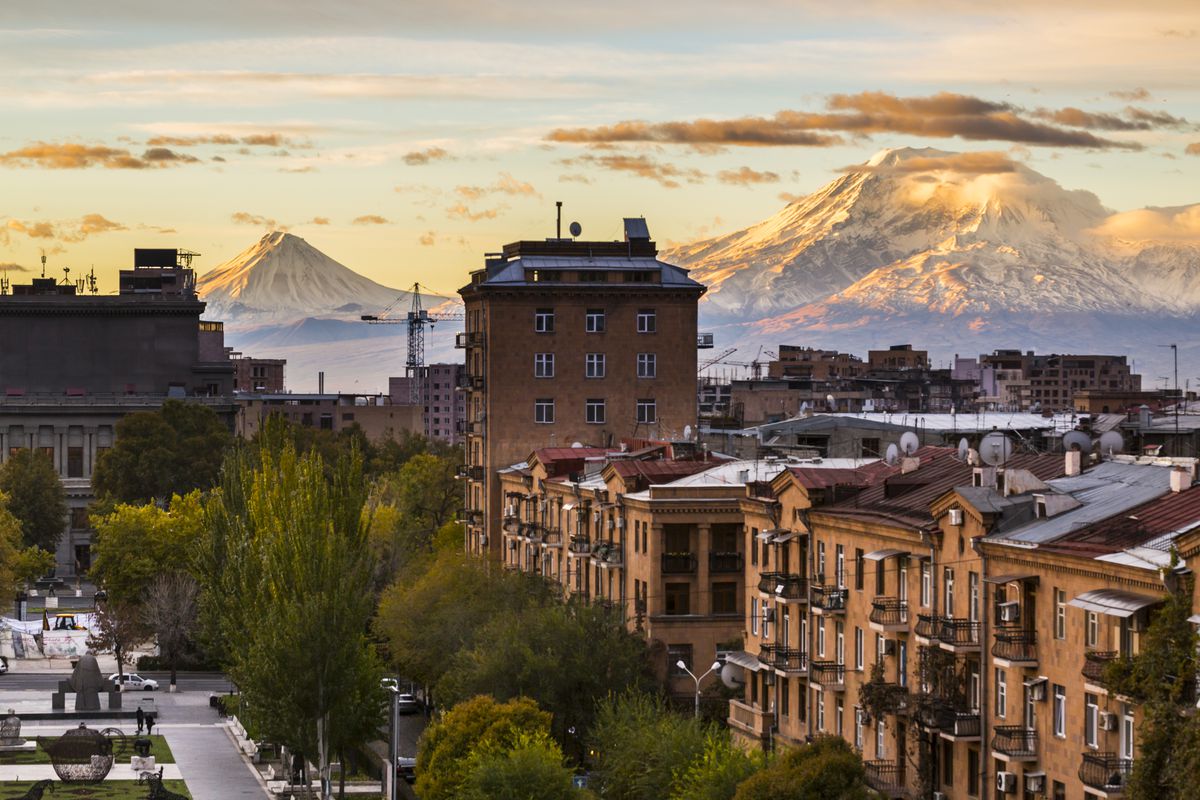
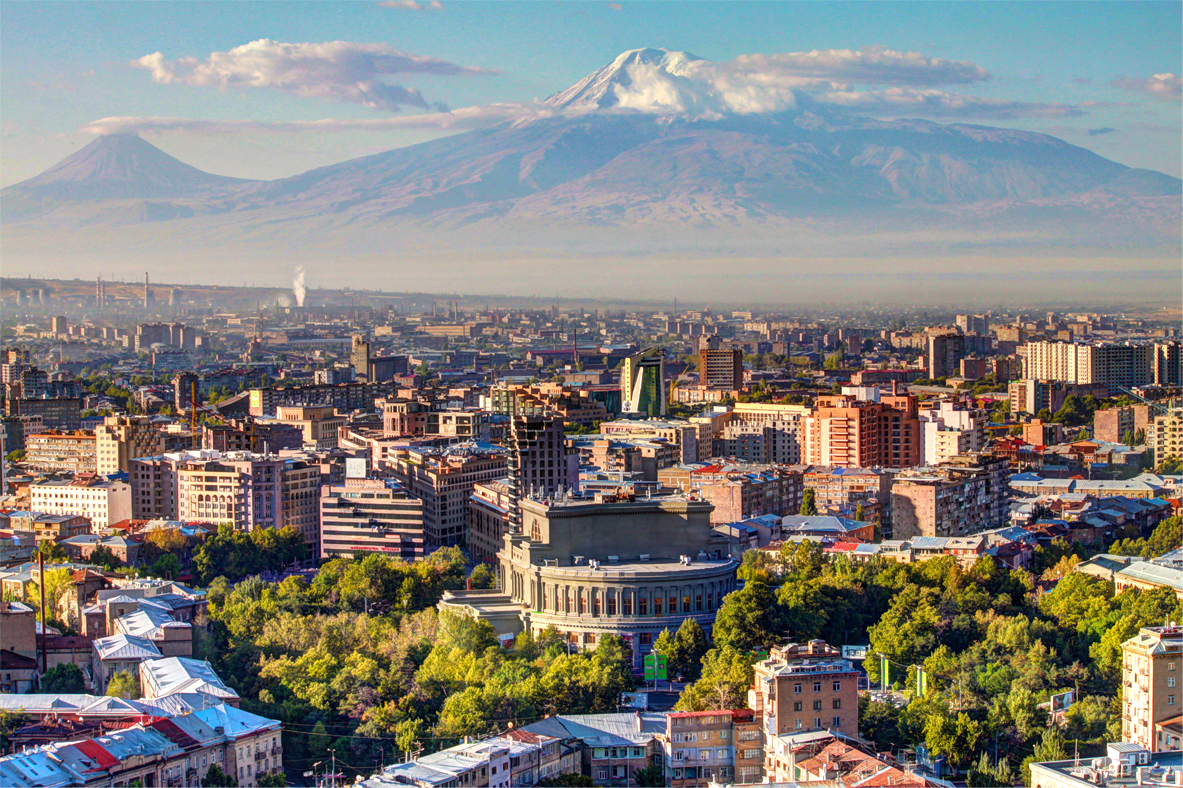
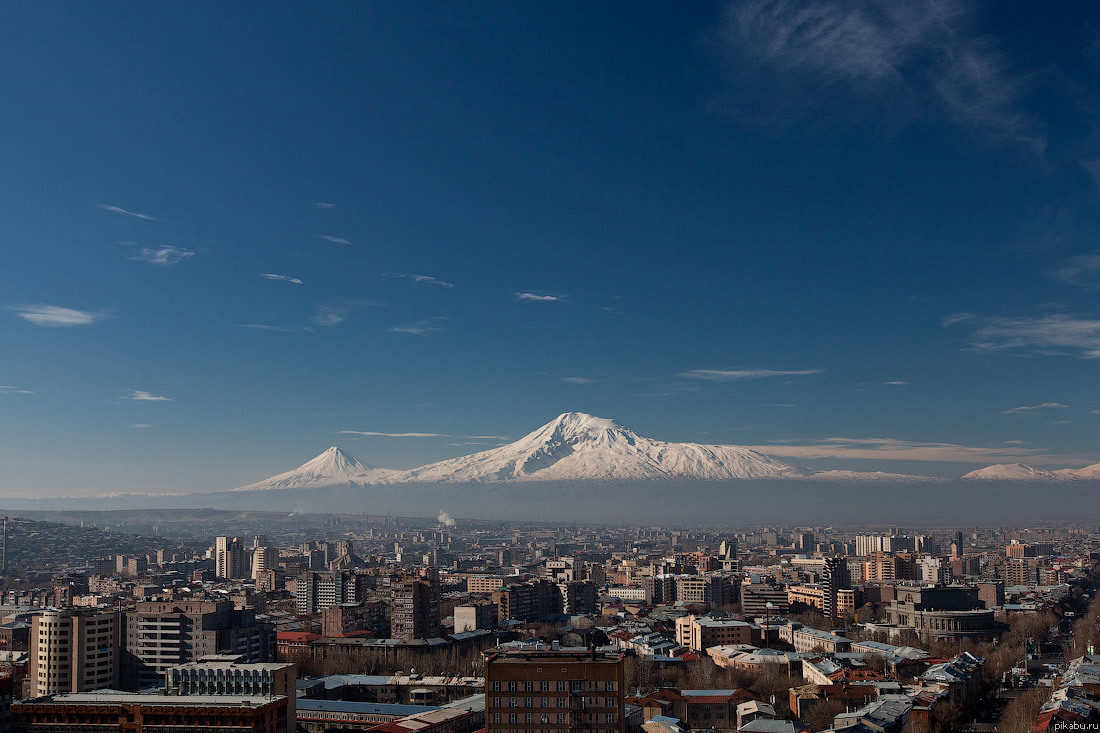
Capital of Armenia- one of the ancient cities in the world. According to researchers and scientists the name of the city comes from the fortress Erebuni which was built by Argishty I, the King of Urartu, in 782 B.C. In 2008 Yerevan celebrated its 2790 – year anniversary . The Cuneiform which was found during excavations of the fortress of Urartu and was situated on the city boundaries, says ,- “ Argishti Menua’s son built this powerful fortress and gave it the name Erebuni for the power of the country Biaini(Urartu) and for the frightening of enemy countries.
Today Yerevan is a modern city with population of 1.200.000. The city is located in the north-eastern part of the Ararat Valley at a height of 900-1300 meter above sea level in the area of 270 square kilometres. Through the city flows the Hrazdan River. Yerevan is the political, economical, cultural and scientific center of Armenia. The museums of Yerevan are of special value for guests of the city. The most remarkable of them are the Matenadaran – the depository of ancient manuscripts, the History Museum of Armenia, the National Picture Gallery, and the Museum-Fortress Erebuni, the Museum of Modern Art, the Museum of Folk Art, the Museum of Russian Painting, Children’s Picture Gallery. There are a lot of theatres and concert halls for theatre and music lovers , the main of which is one of the most monumental architectural buildings of Yerevan -the building of National Opera and Ballet. There are also modern hotels, great number of restaurants, cafes, cinemas, casinos and night clubs, the Water Park , Botanical Garden and Zoo for the guests of the capital. Everywhere in the city there are markets and trades of skilled craftsmen in the open air which give the city a unique eastern color.
Khor Virap – The monastery complex of Khor Virap is located just on the border of Armenia with Turkey, on the hill which is in the front side of Mt. Ararat. In the 4th century on the site of pit of ancient Armenian capital Artashat one of the first Armenian churches was built here. Gregory The Illuminator , the First Patriarch of Armenian Church, was imprisoned exactly in this deep cave and spent here more than 14 years for his devotedness to the Christianity . From the hillside where the monastery Khor Virap was built , you can watch the majestic view of Ararat. According to the biblical legend the Noah’s Ark landed on the top of Ararat.
Echmiadzin.
It is the administrative and spiritual center of Armenian Apostolic Church. The Cathedral, Spiritual Academy, Synod of the Armenian Church, Treasury, Library, printing-house and other monastery structures are placed on the territory of Saint Echmiadzin. The Cathedral of St. Echmiadzin is the oldest Christian temple of Armenia and one of the first temples in the world. If we translate the word “Echmiadzin” from Armenian it means ” the site of descent of the begotten”. The foundation of the temple was laid in 301 on the place pointed by Gregory The Illuminator. According to the legend the First Patriarch of Armenia saw the Christ in his dream who showed the site where the first Armenian temple should be constructed. The cathedral preliminary built in the form of Basilica was reconstructed in 483 and then it had a cross-like shape crowned with wooden dome. It was replaced with stones in the 7th century. This composition of the cathedral facade is preserved without any changes up to now. In the 17th century a three-tier belfry was arranged in front of the cathedral’s western entrance and six-column rotundas were erected above Northern, Southern and Eastern conches in the 18th century. The frescos of the cathedral also belong to the period of 18th century. Three more monuments of Armenian classical architecture can also be seen in Echmiadzin : Churches of St. Hripsime, Gayane and Shoghakat were built on the site of torturous death of first Christian women who according to the legend came here at the end of the 3rd Century from Roman Empire. The Cathedral of St. Hripsime was built in the 7th Century and is a pattern of perfection of Armenian church architecture. The Cathedral is triumphal and has a crystal brightness. The construction of St. Gayane temple also dates back to 7th century. Erected in the form of domelike basilica the temple was completely renovated in 17th century. The construction of St. Shoghakat Cathedral built on the place of 4th century chapel belongs to the 17th century as well.
Zvartnots.
The Temple of Vigil Forces or Zvartnots built in the 7th century not far from Echmiadzin is perhaps the most imposing construction of Armenia’s church architecture of early medieval period. The three-storied building of the temple with the height of 30 m is different due to courageous architectural decision and richness of decorations. The composition of equal-end cross, inscribed in the circle, was laid in the basis of the structure. The construction of the temple unfortunately could not bear the severe earthquake of the 10th century which destroyed this unique architectural monument. Nevertheless the ruins of the temple allow to judge about its grandness and richness of the relief decorations.
Ashtarak.
It is an administrative center of Aragatsotn region which is spread at the bottom of Mt. Aragats on both slopes of the picturesque gorge of Kasakh River. Ashtarak is rich in architectural monuments of early and late Middle Ages. The most significant monuments are Tsiranavor Basilica (5th century), Churches Karmravor (7th century), St. Marine (13th century) and the three-arch bridge across Kasakh River (17th century).
Oshakan. The church with the tomb of Armenian literacy creator Mesrop Mashtots is situated here. The Armenian alphabet which Armenians use up to nowadays was created by this scientist in 405.
Saghmosavank.
The Monastery complexes of Saghmosavank and Ohanavank constructed in the 13-14th centuries are located on the edge of the picturesque gorge of Kasakh River at the distance of 5 km from each other. The first one of these temples was famous for its library and possesses an excellent acoustics. The second one is significant for refined decorations and the biggest belfry-rotunda in Armenia.
Amberd.
Fortress-castle Amberd being the family property of Pakhlavouni princes is located on the southern slope of Aragats Mount at the height of 2300 m above sea level. The fortress preserved in relatively good conditions with adjacent to its territory is erected on the inaccessible plateau the slopes of which are steeply inclined down to the deep gorge.
Noravank.
The Monastery Noravank is situated at the edge of curvy canyon among fantastic sheer red rocks. The most significant construction of the architectural monument is church of the Blessed Virgin built in the 14th century by talented sculptor and miniaturist Momik. The peculiarities of this highly artistic monument of the medieval Armenian architecture are the unique relief images of Godfather blessing the crucifixion of Christ on the window tympanum of St. Karapet church vestibule and Godmother with the infant and archangels Michael and Gabriel as well as waist-high image of Christ and figures of Apostles Paul and Peter on the walls of the Blessed Virgin church. On the territory of the monastery many khachkars (“cross-stones”) are preserved among them the creations with Momik’s tracery carving is distinguished.
Gladzor.
Gladzor University, one of the most famous educational centers of medieval Armenia was established on the territory of Vayk in the beginning of 1280. There were accepted and taught. such classical disciplines as Divinity, Grammar, Rhetorics, Logics, Arithmetics, Geometry, Astronomy and Music in medieval Armenia The book depository of the University contained thousand volumes of Greek and Armenian books which were sufficient to get comprehensive education in the course of 7-8 year- studying in the University.
Sevan.
The coasts of Lake Sevan , the blue pearl of Armenia, are rich in architectural monuments of various periods. On the top of the rocky island of the lake a monastery surrounded with high fortified wall with many solid structures was found. Churches of St. Astvatsatsin and Apostles are preserved up to nowadays. There are also the ruins of Urartian fortress dating back to the 8th century B.C. and other historical monuments on the coast of the lake.
Noradouz.
The medieval cemetery with good preserved khachkars (cross-stones) of the 10-16th century is located at the edge of community Noradouz on the shore of Lake Sevan. Among these khachkars there are a lot of highly-artistic compositions. Khachkar is a typical Armenian work of sculptural art. It is a stone stela with the cross image occupying the central part of the whole composition of the sculpture. The upper and lateral borders of the khachkar are covered with vegetable or geometric ornaments.
Garni.
The impregnable citadel located on the rocky triangular ledge at the edge of the deep gorge of river Azat served as the royal summer- residence from the 3rd century B.C. up to the 4th century A.D. The area of the citadel is a real archeological museum under open sky. The exceptional structure of the architectural complex is the pagan temple of the sun (1st century A.D.) which represents a classical construction of antique era: rectangular construction surrounded with 24 ionic columns from all sides. The walls, cornice and caps of the temple are decorated with rich ornaments, graffiti and bas-reliefs.
Geghard.
Upstream of Azat River lies Geghard monastery, glorious for its rocky architecture. This splendid monument of medieval Armenian architecture constructed in the 12-13th centuries stands on the slope of reserved natural amphitheatre of sheer rocks encircled by severe and divine nature. The churches of the monastery and the funerary chamber of royal family who owned the monastery are carved in monolithic rock and are the result of architect Galdzak’s work. The structures of the temple are struck by architectural forms-shapes and by luxurious sculptural trimming. The territory of monastery is covered with highly artistic khachkars.
Kecharis.
The resort city Tsakhkadzor (Gorge of flowers) is cosily disposed in picturesque lumber valley bordered with Pambak Mountain Range. This is the beloved resort place of the Armenians and guests. The Monastery Complex Kecharis (11-13th centuries), being the former big spiritual center of medieval Armenia with the school is located just in the center of the city. The proportionality of temple structures adds not only beauty but also majesty to this construction.
Sanahin.
The architectural complex of Sanahin Monastery is located on small plateau near the gorge of Debed River flowing through Lori region. It is an amazing land of wooded mountains and deep gorges, alpine meadows and impetuous mountainous streams. For 4 centuries starting from 10th up to 13th centuries Armenian architects of various generations created wonderful constructions on the relatively small territory. Churches of St. Astvatsatsin , Amenaprkich and St. Gregory, erected in different periods, as well as gallery buildings, academies, book depositories and belfry are distinguished due to immaculate assemblage, integrity of compositional intention and uniformity. For centuries Sanahin Monastery Complex had been considered as an educational center of medieval Armenia. The Academy of Humanitarian sciences and medical college where many outstanding scientists and representatives of national culture worked were functioning here. Sanahin bridge is an eminent architectural construction of the 12th century according to its engineering-artistic peculiarities. This one-span arch bridge crosses Debed River. Its semi-circular arch has the span of 18 m; the height of the mean section of the bridge above water is 12 m. The high quality of stone laying under faultless engineering calculation gave the excellent firmness thanks to which it continues to serve to people up-to-day.
Haghpat.
The Monastery of Haghpat, one more distinguishing creation of Armenian architects, is situated on the plateau in front of Sanahin Monastery. The structures of this architectural complex constructed in the 11-13th centuries belong to such monuments the artistic level and scientific significance of which are beyond the national boundaries. The latter circumstance was assumed as the basis for UNESCO to include Haghpat Monastery into worldwide cultural heritage of humanity. The churches of St. Astvatsatsin, St. Nshan, St. Gregory, dining hall, book depository and belfry are numbered as the monuments of Haghpat Monastery. The attendants of Haghpat high school had lectures on divinity, humanitarian sciences and painting.
Tatev.
Tatev Monastery, the biggest religious and educational center of Medieval Armenia, stretches at the edge of deep gorge of Vorotan River, near the village having the same name. The architectural complex perfectly harmonizes with surrounding it landscape of mountainous Syunik region. The main structure of Tatev Monastery is the temple of Peter and Paul Archangels constructed in the 9th century as well as St. Gregory church with adjacent gallery serving as a university building; other adjacent structures were erected in successive centuries. The prosperity of Tatev University was observed in the 14th century when according to the evidence of present scientists functioned three departments: the first for music teaching, the second for painting art and the third for external (pagan) and inner (church) sciences.
Haghartsin.
Monastery of Haghartsin erected in 11-13th centuries by several generations of Armenian architects is spread over on the emerald plain forsaken among forests of Dilijan Reserve. Churches of St. Astvatsatsin, St. Stephan, St. Gregory, the funerary chamber of Bagratuni royal family, the dining hall and other monastic buildings are skillfully inscribed in the surrounding wonderful landscape named “Armenian Switzerland”.
Goshavank.
Upstream of River Aghstev on the slope of the gorge overgrown by oak forest, lies the Monastery of Nor Getik or Goshavank. The churches of St. Astvatsatsin, The Gregory Illuminator, the book depository with belfry, the school building and the galleries were created in the 12-13th centuries. The monastery had the fame of big educational center of Medieval Armenia connected with Mkhitar Gosh’s name, the author of remarkable fables and law book which had been serving to justice not only in Armenia but also in neighboring Georgia for centuries. There is also big quantity of original khachkars preserved on the territory of the monastery.
Yereruyk.
Not far from Akhuryan River which serves as a natural border between Armenia and Turkey, in ancient community Yereruyk, the walls of the 5th century basilica, bearing the same name, are preserved. This imposing three-nave basilica is one of the oldest Christian constructions of Armenia and even though only the remains stand it was not essentially modified. The basilica is a rectangular hall divided into three aisles by two rows of columns. Regardless of its dilapidated state Yereruyk Basilica is very interesting from archeological viewpoint.
Harich.
Monastery Complex Harich which served as the summer-residence of Armenian Catholics in 19th century, is located on the rocky height at the bottom of Western slope of Mt. Aragats. The main constructions of the monastery – St. Astvatsatsin Church, St. Gregory Church, the chapel on the top of the rock, which deflected from main monoliths during the earthquake, were erected in different periods: 7-13th centuries.
Marmashen.
Built in 10-11th centuries Monastery of Marmashen stretches on the valley of Akhuryan River. The cathedral church of the architectural complex is the integrate and complete embodiment of cross-like doom concept in the doom hall which is the beloved principle of Armenian medieval architecture.
Jermuk.
City-resort Jermuk is situated in the south-eastern part of Armenia at the height of 1980-2070 metres above sea level. The name of the city is translated as “mineral spring”. The resort is located in the upper Arpa River in the two flat plateaus divided by a pictorial gorge over which a beautiful arched bridge is built. The city is surrounded by mountains covered with a deciduous wood and alpine meadows. The climate of the city is high-mountainous, with gently cold winter and gently warm summer. The adornment of the nature of the area is an exclusively beautiful waterfall dashing from the height of 70 metres. The main medical factors of the resort are the mineral waters which are used for inside and for outside use, as well as the natural-climatic conditions of the high-mountainous region.
Dilijan.
In the north-eastern part of Armenia at the turn of the three pictorial mountainous valleys is situated a nook of nature of rare beauty. Since olden days there has existed a proverb in Armenia:”If there were woods, hills and springs in paradise, paradise would look like Dilijan”. City-resort Dilijan with all its countryside called “Armenian Switzerland” is a national reserve. It spreads out at the height of 1250-1500 meters above sea level by the banks of stormy Axstev River. The gorge of the Dilijan reserve is bordered from all sides with Caucasian chain of mountains covered with deciduous and coniferous forests. The climate of the region is soft, with cool summers and warm winters. The natural-climatic conditions of Dilijan are similar to those of Davos in Switzerland and Russian Kislavodsk. In the neighborhood of Dilijan which is worthy of the painter’s brush one can see the masterpieces of medieval architecture of Armenia- monasteries Haghartsin and Goshavank, raised apart from the populated area, surrounded by the primeval forest and marvelous mountainous scenery.
Sevan.
The pearl of Armenia – Lake Sevan, is located in the north-eastern part of Armenia at the height of 1900 metres above sea level. In opinion of many experienced travelers the Sevan is the most high-mountainous from the nice lakes and the most beautiful from the high-mountainous lakes of the world. Armenian proverb says: ”Sevan is so wonderful that one wants to sink in it”. This wonder of the nature was a source of inspiration of many poets, writers and painters of Armenian generation who devoted to it wonderful works of literature and art. “The huge cup” full of sweet water is bordered by mountainous tops of Caucasia. The length of the lake is 70 km, the most wide place is 30 km, a small depth-80m. The lakeside of Sevan is a favourite place for summer rest for inhabitants and guests of Armenia. Fresh air, sunny weather, clean water and golden sand create ideal conditions for the rest at the shore of the lake.
Armenia is known all over the world as an open air museum. Tourists can enjoy over 4,000 historical monuments throughout Armenia, from various periods of the country’s history- dated from prehistoric to Hellenistic time, and from early to medieval Christian era. For centuries, Armenians have created unique and remarkable culture in the crossroads of east and west.
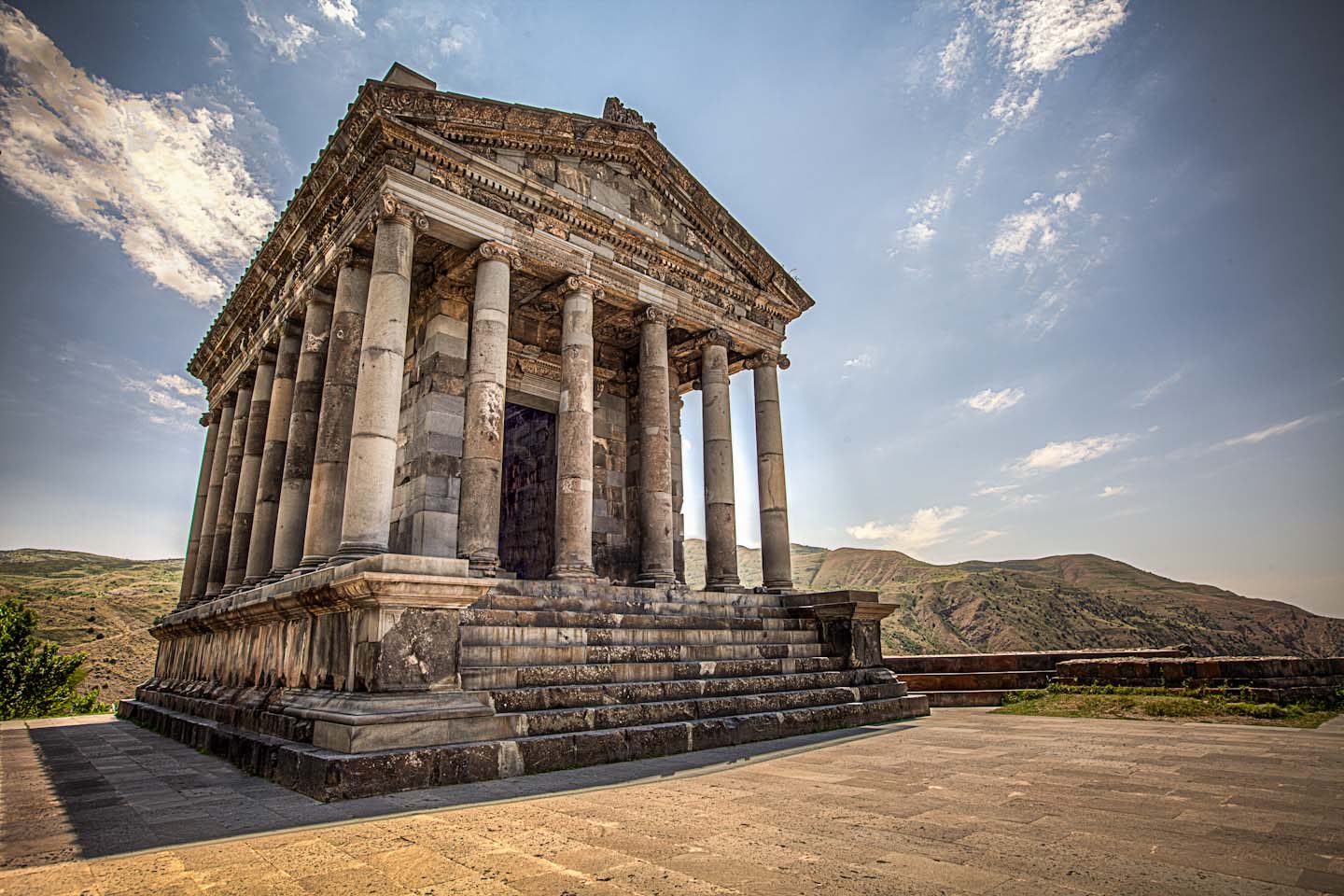
In 301AD, Armenians were the first nation who officially adopted Christianity as a state religion, which influenced developing Armenian culture, and particularly architecture. Instead of pagan temples first Christian churches were built. So architectural masterpieces such as the churches of Hripsime, Gayane and the gem of 7th Century Armenian architecture, Zvartnots cathedral were created. In the 10-13th centuries new architectural styles developed into the monastery complexes of Geghard, Sanahin, Haghpat, and Haghartsin and now we can say the traditional architecture of Armenia is reflected in architecture of churches and monasteries. The early Middle Ages architecture (5 th – 6 th centuries) is represented, basically, by basilicas. A basilica is a structure of rectangular shape divided, as a rule, into three parts by rows of columns; the central part towers over the others. Monastery complex which consists of a number of elements – a temple, chapels, belfries, household buildings – refectory, library,is a special type of temple architecture. Each culture possesses a certain original element which becomes a symbol of entire national culture. In Armenia such symbol is “khachkar”, so-called cross-stones, which are not found anywhere in the world. The word “khachkar” is formed by two Armenian roots: “khach” (cross) and “kar” (stone). Khachkar is a type of art – decorative-architectural sculptures based on ancient national traditions and made in a variety of shapes. Khachkars originated in the beginning of the 4 th century right after the adoption of Christianity.
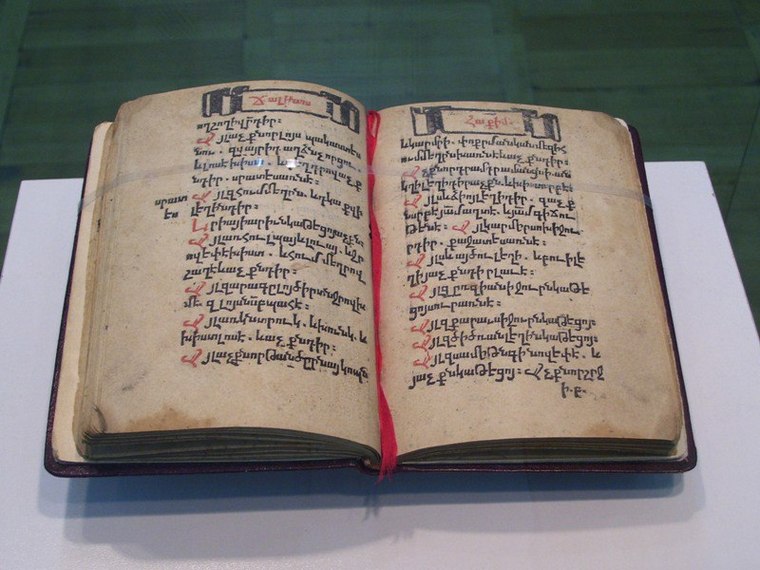
Another revolutionary turning point in the history of Armenian culture occurred when the scholar and philosopher, Mesrop Mashtots, created the Armenian alphabet (5th century). This led to the development of Armenian literature and science, although the first book translated into Armenian was The Holy Bible. Thousands of illuminated manuscripts written before decoration by artists are currently stored in the largest depository of illuminated manuscripts in the world, the Matenadaran, located in the centre of Yerevan.
The Armenian language is beautiful, but difficult ,and it is a part of the larger Indo-European family.
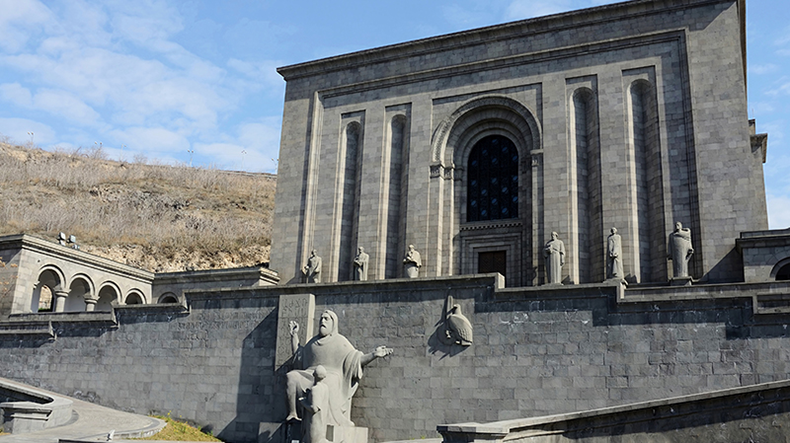
The Mesrop Mashtots Institute of Ancient Manuscripts commonly known to as the Matenadaran is a repository of ancient manuscripts, research institute and museum. It holds one of the world’s richest depositories of medieval manuscripts and books which span a broad range of subjects, including history, philosophy, medicine, literature, art history and cosmography in Armenian and many other languages.
The earliest mention of the term matenadaran, which means “repository of manuscripts” in Armenian, was recorded in the writings of the fifth century A.D. historian Ghazar Parpetsi, who noted the existence of such a repository at Etchmiadzin Cathedral, where Greek and Armenian language texts were kept.
The Matenadaran is in possession of a collection of nearly 17,000 manuscripts and 30,000 other documents which cover a wide array of subjects.

When Armenian written literature began in the 5th century , monasteries became the principal centres of intellectual life. The first great Armenian poet (10th century) was St. Gregory Narekatzi, known for his mystical poems and hymns. During the 16th to 18th century, popular bards, called ashughs, arose; the most famous among them were Nahapet Kuchak and Sayat-Nova (d. 1795), whose love songs are still popular.
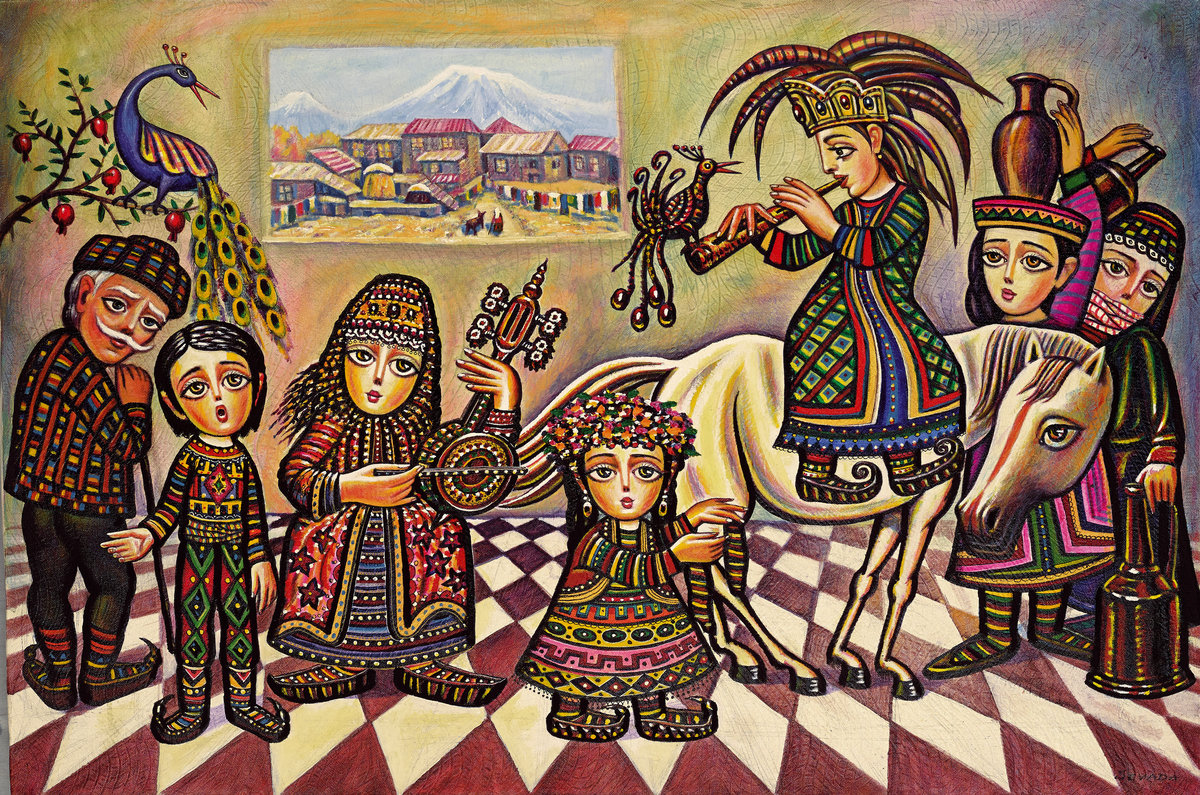
Art has always had its special place in Armenian culture. The works by Martiros Saryan, Minas Avetisyan, Hakob Hakobyan, Rudolf Khachatrian, Gevorg Bashinjagyan and many others can be found in Yerevan’s National Art Gallery. The National Art Gallery in Yerevan has more than 16,000 works that date back to the middle Ages. Visitors can also enjoy works of Armenian art in the Modern Art Museum, the Children’s Picture Gallery, the Martiros Saryan Museum and many other museums and exhibition halls worth visiting. Armenia also has an old established tradition of carpet weaving, and the Armenian carpets are unique with their specific ornaments and colors.
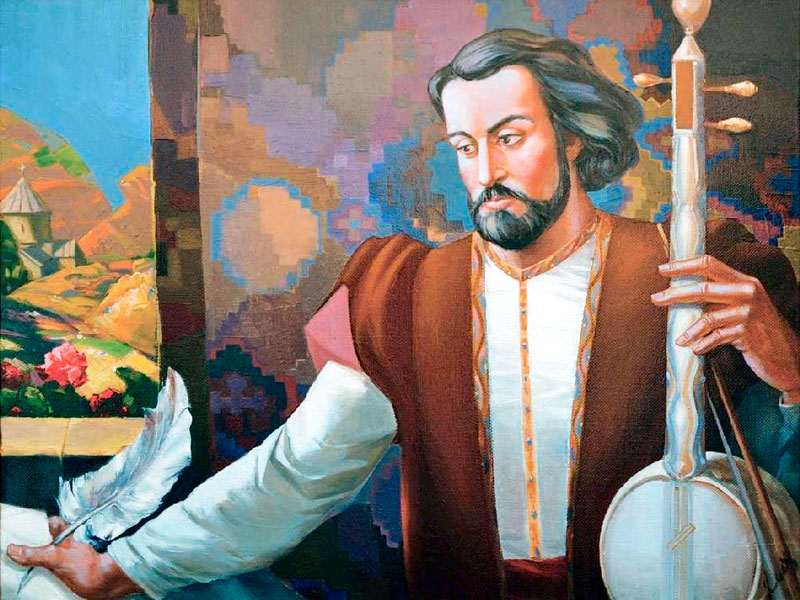
One of the most important parts of Armenian culture is Armenian music, which has developed new styles of music, while maintaining traditional ones too. Sharakans are traditional Armenian liturgical songs, which are experiencing a revival today. Distinctive musical instruments are used to play Armenian folk songs. Sayat Nova and Komitas are among Armenia’s best-known musicians and composers. Contemporary music includes jazz and pop. Sayat Nova Conservatory helps raise and develop future generations of Armenian musicians. Frequent concerts can make one’s evening delightful at the Philharmonic, Chamber Music Hall, Opera and Ballet House in Yerevan.
In 1868 Chukhadzhyan wrote the first Armenian opera “Arshak II”.The works by A. Spendiarov laid the basis of national classical symphony music. “Anush” by Armen Tigranyan is one of the most famous and popular operas, based on traditional Armenian folk songs and dances. The storyline and text is based on Tumanian’s “Anush”. Aram Khachaturyan is of course, the most well known Armenian composer for foreign audience, famous for his, “Spartacus” and “Gayaneh”. He composed the well-known “Sabre Dance” familiar to almost everyone outside of Armenia.
Armenian folk songs are still alive today in Armenia, and the Artist Djivan Gasparian has taken the unique sound of the Armenian duduk to foreign audience worldwide. Other Armenian instruments include the zoorna, dhol, tar and kanon.
Jazz is popular in Armenia, especially in summer when live performances are a regular occurrence at one of the city’s many outdoor cafés and parks.
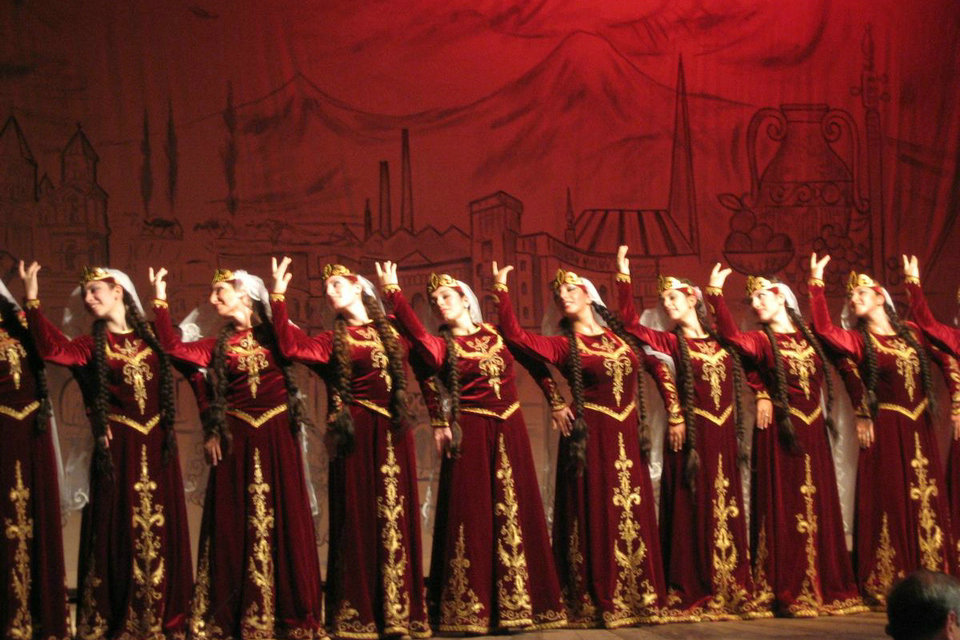
The Armenian dance heritage has been one of the oldest, richest and most varied in the east. Armenian dance is perhaps the most representative of rich fabric of Armenian culture when accompanied by traditional or contemporary Armenian music. The choreography of Armenian dance sets it apart from other oriental forms of dance, and Armenian dance ensembles win countless awards at festivals and competitions throughout the world.

The Yerevan Vernissage is an open-air exhibition-market functioning on the weekends. It was formed during the 1980s by Armenian artists who started to display their art works in the square next to the Artists Union of Armenia.
In addition to carved wood and art works, traditional carpets, old collections of coins and medallions, books, jewellery, musical instruments, needlework, dolls, electronics and even pets are found in the market.
A visit to the market could be a full day excursion on a beautiful weekend day. The Vernissage is the right place to get little taste of Armenia and a special spot to witness the fusion between national traditions and modern taste.. This is your best place to get souvenirs. The Vernissage has certainly been one of the most essential elements of Yerevan’s cultural life.
The most astounding thing about Armenian food is that it is still organic. That’s why tourists visiting Armenia just can’t stop eating our fruit and vegetables as they are all natural, juicy and tasty and the smell of apricots , peaches or tomatoes won’t leave you indifferent.
They say fruit and vegetable are delicious in Armenia because of the rocky land and the Sun. Armenia is rich with various sorts of fruit like apricot, peach, cherry, apple, fig, pomegranate, grapes, plum, quince, pear.
Armenian food is rich with vegetables, greens and spices too,. Armenians also cultivate wheat, rice, peas, beans, walnut, hazelnut and almonds.
Now just imagine the meals prepared with those tasty vegetables and spices with the greens and herbs. Tourists should try Armenian cuisine while visiting Armenia.
Armenian cuisine is as ancient as the history of Armenia. Our cuisine is a combination of different tastes and aromas, various spices, vegetables, fish, and meat.
The pomegranate, with its symbolic association with fertility represents that nation. The apricot is the national fruit.
Lavash – Traditional Armenian Bread
Armenian cuisine is quite popular with its traditional bread called lavash. It is flat, thin and soft bread that is baked in an underground clay oven tonir and can be dried and kept for quite a long time. It is the most widespread bread in Armenia and no festive table can be imagined without lavash.
Lavash symbolizes life and wisdom. In ancient times, lavash was used during battles as it lasted long and saved the soldiers from starvation. Mothers cooked lavash, dried it and put in the bags of the soldiers.
Tourists never leave Armenia without tasting famous Armenian barbecue or khorovats as locals call it. Barbecue is one of the special foods of the Armenian cuisine.
It’s even hard to imagine a wedding, engagement, baptizing, or other celebrations without having Armenian barbecue on the tables.
Armenian barbecue is completely different from American one; it’s usually made of big cuts of pork, not ground beef, and it is cooked on hot coals after burning a wood fire. Before barbecuing the meat Armenians սsually barbecue eggplants, green pepper and tomato. As vegetable barbecue is ready, men line up the skewers with meat on the grill and wait until they are ready. Meanwhile, women start clean the burnt peel of eggplants, green peppers and tomatoes.
The process of preparing barbecue is very important and it is always made by men, who like to play with fire as they associate it with women’s body. The whole idea is to get together and have a great barbecue picnic on a sunny day as Armenian barbecue is usually made outdoors.
Remember, you should eat Armenian khorovats with hands, not knife and fork, yummy!!!
Every year there Armenian Barbecue Festival is held in Akhtala, Lori province. Last year IBF, WBA and WBC champion Vic Darchinyan participated in the Barbecue Festival and opened the statue of famous Armenian actor Armen Jigarkhanyan. The organizers of the Barbecue Festival aim to raise popularity of Armenian national cuisine at world level. Don’t miss the chance to participate in the upcoming Barbecue Festival in Armenia in September this year.
Harisa is a very delicious Armenian dish, kind of porridge, which is made of boned and stewed chicken and cracked or coarsely ground wheat. Harisa is a national Armenian dish.
Dolma is another traditional dish made of minced meat, rice and spices either wrapped in grape or cabbage leaves or stuffed in green pepper, eggplant, tomatoes, etc.
Khash is quite popular, especially during cold weather early in the morning. It’s a typical Armenian soup made of cow’s legs, served with garlic and dried lavash.
Gata is a famous Armenian cake; it’s dough stuffed with butter and sugar, sometimes crispy, very tasty.
Pakhlava is a very delicious dessert; it’s a sweet pastry with honey and walnut.
April: Fish festival in Abovyan of Kotayk region. Come to taste the most delicious fish in Armenia.
May : Tolma festival in Sardarapat, Armavir region. Tolma (Armenian national meat dish) is one of the most favorite and popular dishes for Armenians. The aim of the festival is to make traditional dishes public and to show the richness and diversity of Armenian cuisine. Tolma preparing takes a long period of time and has difficult technology. Traditional “tolma” is made of grape leaves stuffed with minced spiced meat and rice. During the festival different types of tolma (more than 60) made by representatives of different villages and regions are represented.
June: Bread in the Mountains. Traditional ritual and dish festival «Bread in the Mountains» usually is held in June. The aim of the festival is to reveal forgotten national dishes and make them popular. The slogan of the festival is “Perceive your Identity through Taste”. During the festival guests can taste traditional dishes and enjoy a concert. If you want to make some dish the cooks of the festival will share their recipes with you.
June: Sheep shearing festival in Syunik region, in Alidzor village. This festival is organized by IdEA Foundation. Sheep shearing is one of the oldest traditions during which you can watch the process , see Armenian dances and listen to national songs ,take part in sports events .Besides these ones you can taste different national dishes and take photos in national clothes. The main goal of the festival is to make Tatev and its neighborhood popular among tourists and develop economic life of the communities included in the program ,,Tatev revival’’.
July: The 1-st Saturday of July –Festival of Mulberries in Syunik region, town Goris. The purpose of the festival is to get known with traditions of making mulberry vodka and tasting it.
July: National garment festival.
July: International cinema festival “Golden Apricot“.
The First GOLDEN APRICOT Festival took place on June 30 to July 4, 2004. The festival attracted attention from all over the world while including 148 films representing over 70 filmmakers from 20 countries. The Festival international jury consisted of eminent figures in world cinema and film criticism. It was established by the “Golden Apricot” Fund for Cinema Development, the Armenian Association of Film Critics and Cinema Journalists, supported by the Ministry of Foreign Affairs of the Republic of Armenia, the Ministry of Culture of Republic of Armenia and Benevolent Fund for Cultural Development. The Golden Apricot International Film Festival carries the theme Crossroads of Cultures and Civilizations. The title may well serve as our impassioned mantra for building cultural bridges and fostering dialogue. It also reflects the history of Armenia itself, which for millennia has existed as a flash point for competing geopolitical forces. The festival welcomes films representing diverse ethnic groups, religions, and nations that depict the human experience, the daily lives of people, ordinary and extraordinary, their troubles and their joys, as they try to find meaning in a changing world and struggle to redefine themselves in a world that recognizes fewer and fewer boundaries
22 July – Watermelon Festival
The end of July – Raspberry Festival
August: The 2-nd Saturday of August –Festival of carpets in Dilijan, Tavush region. The Armenian carpets and carpet weaving have been developed for many centuries. You will be amazed by color and variety of ornaments of Armenian carpets. At the festival you will also be able to look at works of Armenian artists and masters and to buy their works of art.
August: The Festival of honey and berries in Berd, Tavush region. It is the sweetest and tastiest festival where you can try pure honey and even buy some for winter. You will have an opportunity to eat a lot of berries and have drinks.
September: BARBEQUE FESTIVAL in Akhtala, Lori region. If you are a barbeque lover you should come to Armenia in September. The aim of the Barbeque festival is to present and spread Armenian traditional cuisine, as well as to develop local tourism. During the festival you will have an opportunity to taste different types of traditional Armenian barbeque popular in different regions. The Festival program includes different ways of barbeque making, professional barbecue makers’ competition, home-made barbeque makers’ competition, a national song – concert and other interesting activities.
October : ARENI WINE FESTIVAL in Areni village, Vayots Dzor region. Armenia is famous for its good wine-makers and old traditions of wine-making preserved till nowadays. According to a Biblical legend, winemaking dates back to the time, when Forefather Noah planted grape vine on the slope of Mount Ararat. Archeological explorations found seeds of grapes in Armenia and this fact proves that winemaking has history of centuries in Ararat Valley. Lots of tares and other winemaking equipment have been found in the caves of Areni village.
Traditional “Areni Wine Festival” is a great opportunity to explore Armenia. Wine producing factories and individual wine producers present their products and you will be given a chance to taste Armenian wines and find the best one for you. The program of events includes traditional dancing, singing, food making and tasting, wine-making and tasting, traditional games and competitions. There will be such contests as “Armenia in your eyes”, the best wine -label contest, “Homemade wine producers” contest and “The best souvenir of the festival” contest.
October: The International theatre festival is usually held in Yerevan, where a lot of theatre troops from different countries gather to show their talents of making best performances.
October: the 2-nd Sunday of October.- is the birthday of our capital Erebuni –Yerevan. Yerevan will be 2798 years old. Good weather, warm atmosphere, tasty food, happy people in the streets – all of these you can enjoy on this day, the birthday of our ancient but at the same time young city of Yerevan.